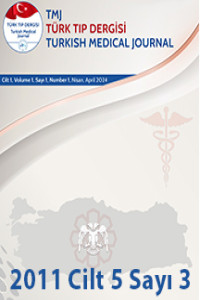Abstract
Amaç: Bu çalışmanın amacı “mesleğe özgü ayakkabı” kullanımının tinea pedis oluşumu ile ilişkisini değerlendirmektir.
Gereç ve Yöntem: Ocak 2009 - Aralık 2011 tarihleri arasında Ankara Meslek Hastalıkları Hastanesi’ne mesleki mağduriyetlerinin tespiti amacıyla başvuran hastalardan mesai saatleri
boyunca metal uçlu ayakkabı kullanma öyküsü olan 53 hasta çalışma grubuna alınmıştır.
Mesleğe özgü ayakkabı giyme zorunluluğu olmayan 53 hasta ise kontrol grubunu oluşturmuştur. Tüm hastalar tinea pedis açısından klinik muayene ve gerekirse laboratuar
tetkikleriyle değerlendirilmişlerdir.
Bulgular: Çalışma grubunda tinea pedis oranı % 47,1 olarak belirlenmiştir. Buna karşın kontrol grubundaki hastaların % 18,9’ unda tinea pedis tanısı konulmuştur. Yapılan ki-kare
testi ile mesleğe özgü ayakkabı kullanımı ile tinea pedis görülme sıklığı arasında istatistiksel olarak anlamlı bir ilişki olduğu ortaya konulmuştur.
Sonuç: Mesleğe özgü koruyucu çelik mokasen ayakkabı kullanımı mesleki tinea pedis oluşumunda
yatkınlığa yol açabilmektedir.
ABSTRACT
Objective: The aim of this study was to evaluate relationship between the use of “professionspecific shoe” and the formation of tinea pedis
Methods: Between January 2009 and December 2011, all of the patients who were admitted to Ankara Hospital of Occupational Diseases for the purpose of the determination of
their grievances related with their occupations were evaluated. Of these patients, fifty three patients who had a history of using steel moccasins shoes during the office hours were
included into the study group. Another 53 workers with no obligation to wear shoes that are specific to the profession formed the control group. By clinical examination and laboratory methods all of the patients were evaluated for tinea pedis.
Results: The frequency of tinea pedis was 47.1% in the study group. Tinea pedis was diagnosed in 18.9% of patients in the control group. With the use of Chi-square test, a statistically
significant relationship between the frequency of occurrence of tinea pedis and the use of steel moccasins shoes was found.
Conclusion: The use of the profession-specific protective steel moccasins shoes can lead to the formation of professional tinea pedis.
Keywords
References
- 1. Sabadin CS, Benvegnú SA, da Fontoura MM, Saggin LM, Tomimori J, Fischman O. Onychomycosis and tinea pedis in athletes from the State of Rio Grande Do Sul (Brazil): a cross-sectional study. Mycopathologia 2011;171(3):183-9.
- 2. Djeridane A, Djeridane Y, AmmarKhodja A. Epidemiological and aetiological study on tinea pedis and onychomycosis in Algeria. Mycoses 2006;49(3):190-6.
- 3. Ogasawara Y. Preval nce and patient’s consciousness of tinea pedis and onychomycosis. Nihon Ishinkin Gakkai Zasshi 2003;44(4):253-60.
- 4. Bae JM, Ha B, Lee H, Park CK, Kim HJ, Park YM. Prevalence of Common Skin Diseases and Their Associated Factors among Military Personnel in Korea: A Cross-sectional Study. J Korean Med Sci 2012;27(10):1248-54.
- 5. Tosti A, Hay R, Arenas-Guzmán R. Patients at risk of onychomycosis-risk factor identification and active prevention. J Eur Acad Dermatol Venereol 2005;19 Suppl 1:13-6.
- 6. Quandt SA, Schulz MR, Feldman SR, Vallejos Q, Marín A, Carrillo L, et al. Dermatological illnesses of immigrant poultry-processing workers in North Carolina. Arch Environ Occup Health 2005;60(3):165-9.
- 7. Arcury TA, Feldman SR, Schulz MR, Vallejos Q, Verma A, Fleischer AB Jr, et al. Diagnosed skin diseases among migrant farmworkers in North Carolina: prevalence and risk factors. J Agric Saf Health 2007;13(4):407-18.
- 8. Smith DR, Choi JW, Yu DS, Ki M, Oh CH, Yamagata Z. Skin disease among staff in a large Korean nursing home. Tohoku J Exp Med 2002;198(3):175-80.
- 9. Sahin I, Kaya D, Parlak AH, Oksuz S, Behcet M. Dermatophytoses in forestry workers and farmers. Mycoses 2005;48(4):260-4.
- 10. Tanaka K, Katoh T, Irimajiri J, Taniguchi H, Yokozeki H. Preventive effects of various types of footwear and cleaning methods on dermatophyte adhesion. JDermatol 2006;33(8):528-36.
- 11. Ghannoum MA, Isham N, Long L. Optimization of an infected shoe model for the evaluation of an ultraviolet shoe sanitizer device. J Am Podiatr Med Assoc 2012;102(4):309-13.
- 12. Lacroix C, Baspeyras M, de La Salmonière P, Benderdouche M, Couprie B, Accoceberry I, et al. Tinea pedis in European marathon runners. J Eur Acad Dermatol Venereol 2002;16(2):139-42.
- 13. Mikhasik SV, Fedotov VP, Leshchenko GM. The characteristics of the clinical manifestations and the pathogenesis of foot mycoses complicated by candidiasis in metallurgists. Vestn Dermatol Venerol 1990;(7):45-8.
- 14. Cohen AD, Wolak A, Alkan M, Shalev R, Vardy DA. Prevalence and risk factors for tinea pedis in Israeli soldiers. Int J Dermatol 2005;44(12):1002-5.
- 15. Djeridane A, Djeridane Y, AmmarKhodja A. A clinicomycological study of fungal foot infections among Algerian military personnel. Clin Exp Dermatol 2007;32(1):60-3.
Abstract
References
- 1. Sabadin CS, Benvegnú SA, da Fontoura MM, Saggin LM, Tomimori J, Fischman O. Onychomycosis and tinea pedis in athletes from the State of Rio Grande Do Sul (Brazil): a cross-sectional study. Mycopathologia 2011;171(3):183-9.
- 2. Djeridane A, Djeridane Y, AmmarKhodja A. Epidemiological and aetiological study on tinea pedis and onychomycosis in Algeria. Mycoses 2006;49(3):190-6.
- 3. Ogasawara Y. Preval nce and patient’s consciousness of tinea pedis and onychomycosis. Nihon Ishinkin Gakkai Zasshi 2003;44(4):253-60.
- 4. Bae JM, Ha B, Lee H, Park CK, Kim HJ, Park YM. Prevalence of Common Skin Diseases and Their Associated Factors among Military Personnel in Korea: A Cross-sectional Study. J Korean Med Sci 2012;27(10):1248-54.
- 5. Tosti A, Hay R, Arenas-Guzmán R. Patients at risk of onychomycosis-risk factor identification and active prevention. J Eur Acad Dermatol Venereol 2005;19 Suppl 1:13-6.
- 6. Quandt SA, Schulz MR, Feldman SR, Vallejos Q, Marín A, Carrillo L, et al. Dermatological illnesses of immigrant poultry-processing workers in North Carolina. Arch Environ Occup Health 2005;60(3):165-9.
- 7. Arcury TA, Feldman SR, Schulz MR, Vallejos Q, Verma A, Fleischer AB Jr, et al. Diagnosed skin diseases among migrant farmworkers in North Carolina: prevalence and risk factors. J Agric Saf Health 2007;13(4):407-18.
- 8. Smith DR, Choi JW, Yu DS, Ki M, Oh CH, Yamagata Z. Skin disease among staff in a large Korean nursing home. Tohoku J Exp Med 2002;198(3):175-80.
- 9. Sahin I, Kaya D, Parlak AH, Oksuz S, Behcet M. Dermatophytoses in forestry workers and farmers. Mycoses 2005;48(4):260-4.
- 10. Tanaka K, Katoh T, Irimajiri J, Taniguchi H, Yokozeki H. Preventive effects of various types of footwear and cleaning methods on dermatophyte adhesion. JDermatol 2006;33(8):528-36.
- 11. Ghannoum MA, Isham N, Long L. Optimization of an infected shoe model for the evaluation of an ultraviolet shoe sanitizer device. J Am Podiatr Med Assoc 2012;102(4):309-13.
- 12. Lacroix C, Baspeyras M, de La Salmonière P, Benderdouche M, Couprie B, Accoceberry I, et al. Tinea pedis in European marathon runners. J Eur Acad Dermatol Venereol 2002;16(2):139-42.
- 13. Mikhasik SV, Fedotov VP, Leshchenko GM. The characteristics of the clinical manifestations and the pathogenesis of foot mycoses complicated by candidiasis in metallurgists. Vestn Dermatol Venerol 1990;(7):45-8.
- 14. Cohen AD, Wolak A, Alkan M, Shalev R, Vardy DA. Prevalence and risk factors for tinea pedis in Israeli soldiers. Int J Dermatol 2005;44(12):1002-5.
- 15. Djeridane A, Djeridane Y, AmmarKhodja A. A clinicomycological study of fungal foot infections among Algerian military personnel. Clin Exp Dermatol 2007;32(1):60-3.
Details
| Primary Language | Turkish |
|---|---|
| Subjects | Toxicology, Dermatology |
| Journal Section | Research Article |
| Authors | |
| Publication Date | December 26, 2011 |
| Published in Issue | Year 2011 Volume: 5 Issue: 3 |



